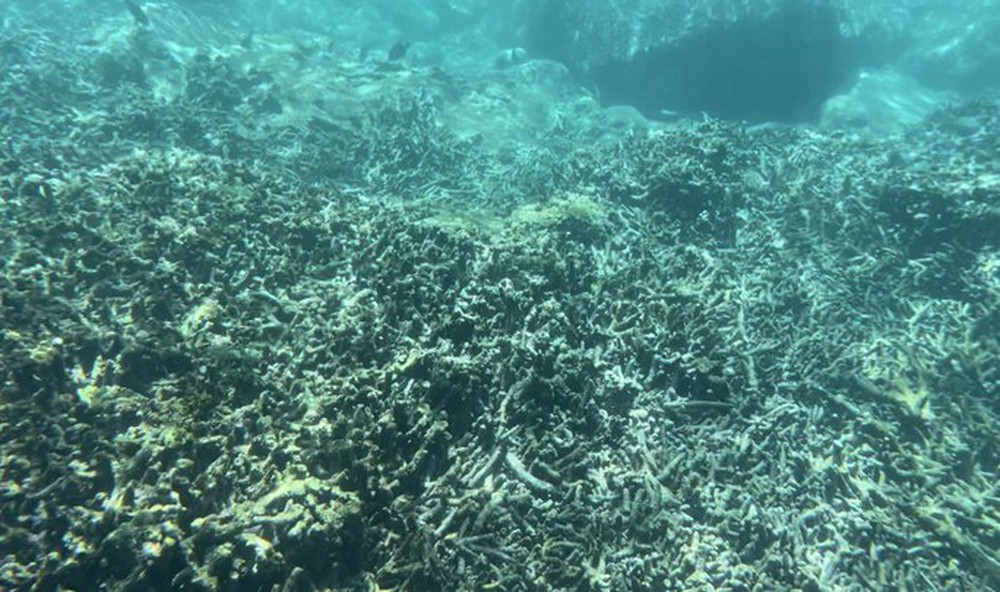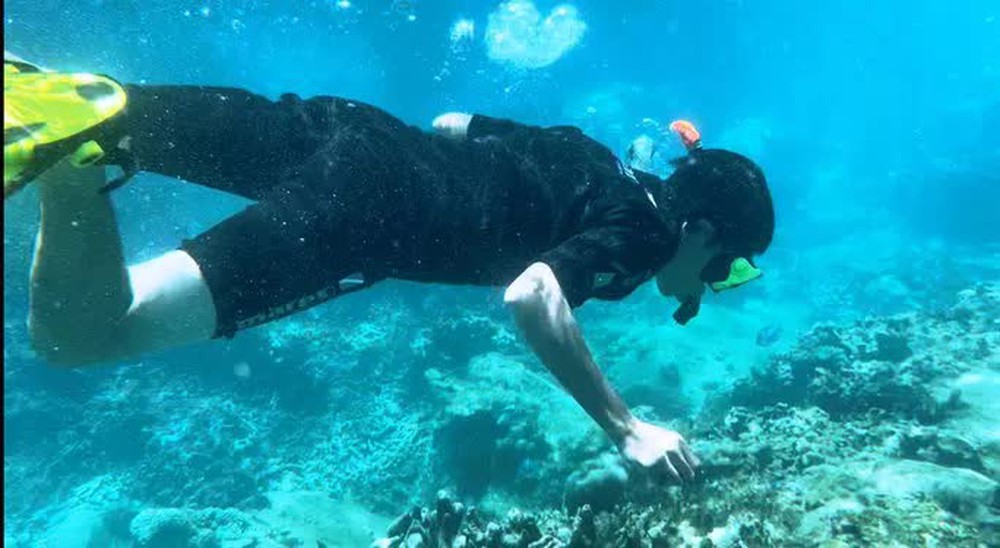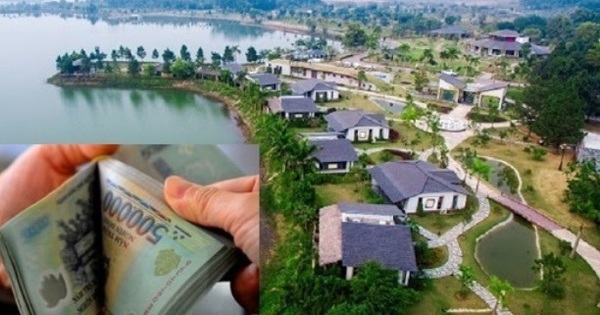Nha Trang Bay Marine Conservation: SOS!
In the early days of June 2022, the reporter of Newspaper Workers chartered boats and guides to assist scuba diving to clarify the above situation.

Marine ecosystems, corals… white dead, peppered
Ruined, desolate
As someone who has lived and worked in Nha Trang city (Khanh Hoa province) for more than 15 years, I really couldn’t believe it when I heard some divers say that “it’s all ruined. Nha Trang bay“. After 2 years of the Covid-19 epidemic, tourism with sea and island tours, diving to see coral reefs and lakes have all stopped. This is the time to restore and thrive coral reefs and marine ecosystems. No way. Everything happened in reverse in Nha Trang Bay Marine Reserve, so I decided to pay for a boat rental and a diving guide to help me see the seabed.
And, when I dived myself at various points in Hon Mun to see with my own eyes, I saw that Hon Mun was already shabby, it was not wrong!
Recorded at the diving site in North Hon Mun, this area has an average depth of 2-10 m. Many tours are bringing visitors here to experience diving. With professional diving gear, we approached the coral reefs before. However, I only see here scattered clusters of soft corals, brain-shaped, mushrooms and quite a few horn corals. Most marine creatures are also small, with few colors. In particular, there are garbage and some pieces of net clinging to the coral, even though this is a prohibited fishing area.
More seriously, in the Northeastern area of Hon Mun, which scuba divers call Mama Hanh beach, the amount of marine life and coral reefs is shockingly ruined, corals are broken in series. “This area is a place where diving is allowed in Hon Mun. Previously, the coral reefs were very beautiful and rich, but now they are ruined. Sea creatures have lost their homes, so they are no longer there. The sea floor is only left. gray color. It’s so heartbreaking to look at, like someone poured sand on my rice bowl. We were in tears,” – my diving guide, who had just emerged from the water, pulled out the steam tube, said sadly. .
We continue to survey the area southwest of Hon Mun. The further west, the more dead corals. We often had to roll our eyes at the sight of the entire coral carpet being broken, whitening the entire sea to the east of the wharf. Tons of white dead coral were hit by the waves in a thick layer on the island. Here, I met Mr. Do Thanh Quan, a professional diving guide for tourists for the past 20 years in Nha Trang. He said shocked: “We used to call this place a paradise under the sea because the amount of coral and marine life is very rich. I have dived in many places but have never seen a place as beautiful as this place. But now white dead coral, looks like a graveyard!”.
Continuing the survey at Hon Tam, the situation of broken corals and mass death also happened similarly. The seabed in this area is also shabby, the amount of sea fish and marine life is almost very little. It was very difficult for us to see a fish the size of a hand.

The reporter of Nguoi Lao Dong Newspaper surveyed the seabed in the southwestern area of Hon Mun in Nha Trang Bay Marine Protected Area
The rate of coral cover has decreased significantly
According to information from Khanh Hoa Provincial People’s Committee, Nha Trang Bay is one of the most important areas for marine conservation and marine tourism. Coral reefs of international importance and highest biodiversity in Vietnam include more than 220 species of reef fish, over 350 species of coral (accounting for 40% of coral species in the world), 120 species of molluscs, 70 species of crustacean, 30 species of echinoderm, 70 species of seaweed and 7 species of seagrass… The coral reefs in this marine reserve cover an area of about 252 hectares with very high coverage and are concentrated in different areas. Hon Mun (22 ha), Hon Tam (20 ha), Hon Rom (3.2 ha), Hon Vung (4.6 ha)… In which, Hon Mun and Hon Rom have relatively stable coral reefs.
However, through a survey of a newspaper reporter Workers Even the coral reefs in Hon Mun and Hon Rom areas are now desolate and desolate. Mr. Huynh Binh Thai, Head of Management Board (MB) of Nha Trang Bay, assessed this as an alarming situation.
According to Mr. Thai, in mid-June 2020, in this marine protected area, the coverage of live coral is up to 61%. Many groups of fish increased in size and number. Even when diving, you can encounter groupers weighing up to 7-8 kg; The eels are 3-4 m long. Now it’s completely different.
A recent survey by the Management Board shows that the coral quality in Hon Mun is below average. In particular, the southwestern area of Hon Mun has very poor coral reef status, the coverage rate is only 7.8%. Coral reefs died, waves hit the shore extending a beach up to 600 m wide2. In the Southeast, coral coverage is also only 14.5%; on the shore, a dead coral reef 300 m . wide2.
Mr. Thai said that compared to 2015, the average coverage of coral reefs in Hon Mun has decreased significantly, especially in the Southeast – Southwest region, from 52.2%, now only 11.1%.
During the days when we were diving in this marine reserve, it was known that a person from Ho Chi Minh City also had a diving trip here. When he returned, he wrote on his personal page painful words: “Over a year and a half, I have returned to diving at Hon Mun since October 2020. Thought I had to see the sea revived and beautiful, richer than before the epidemic. Many times. But no! The seabed is now desolate…, black, shriveled. I don’t understand what the Hon Mun Marine Protected Area Management Board did to make the sea so shabby?”.
Strictly protected area
Nha Trang Bay Marine Protected Area includes islands such as: Hon Mun, Hon Tre, Hon Mieu, Hon Tam, Hon Mot, Hon Cau, Hon Vung… and surrounding waters. The total area is about 160 km² including 122 km² of water around the islands. In particular, Hon Mun is a strictly protected area because it has the richest and most diverse ecosystem in Vietnam. Nha Trang Bay currently has about 15 diving sites, of which the most beautiful and diverse is around Hon Mun – the core area of the marine reserve – so scuba diving activities must be approved by the Nha Trang Bay Management Board.
Next period: Who “killed” the core region?
at Blogtuan.info – Source: Soha.vn – Read the original article here



